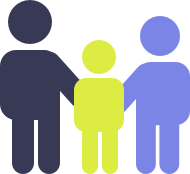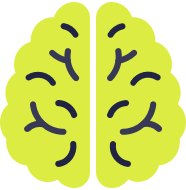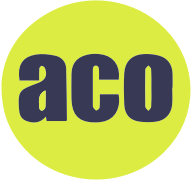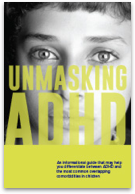TREATMENT APPROACHES
Pharmacologic treatment is a cornerstone of the ADHD treatment plan in pediatric patients1
Although the primary intervention has always been medication, long-term studies demonstrated that multimodal therapies are likely to produce optimal results.2
Nonstimulants vs Stimulants
Choosing between ADHD treatment regimens
Medications may play an important role and are used to treat core symptoms of ADHD, including inattention, hyperactivity, and impulsivity3
There are 2 main categories of ADHD medications1:
- Controlled medications/stimulants
- Noncontrolled medications/nonstimulants
- Oldest/most commonly prescribed class of medication in ADHD
- Works on the central nervous system to improve attention and reduce hyperactivity3
- Fast acting, but symptoms may “rebound” (occur again) in the late afternoon or evening5
- Common side effects are loss of appetite, weight loss, and difficulty sleeping4
- May exacerbate tics, anxiety, or substance use disorder, so they should be used cautiously in patients with these conditions6
- Can take 2-12 weeks to be fully effective7
- Often less effective than stimulants, though can help reduce hyperactivity and impulsivity3,8
- Not a controlled substance4
- Reduced risk of potential abuse compared to stimulants5
- Common side effects include mood changes and fatigue5
- Less common, but more serious side effects include dizziness or drop in blood pressure4
- In rare cases, can cause liver problems9
Combination therapy10
When a child responds only partially to one treatment, the provider may try combining both categories.
Efficacy, onset of action, duration of action, and tolerability are all important factors when establishing an ADHD treatment regimen and deciding between agents.
Multimodal Treatment Plan
A multimodal treatment plan that incorporates a variety of strategies is recommended for patients with ADHD2
Long-term data support combining nonpharmacologic with pharmacologic interventions as more effective in improving outcomes for children and adults with ADHD than either treatment alone.2
For children with ADHD who are preschool age (<6 years old), parent- and/or teacher-administered behavioral therapy is recommended as first-line treatment.1
Examples of successful nonpharmacologic treatment strategies for ADHD are outlined below. As with medication management, a nonpharmacologic treatment approach should be tailored to each patient. Often a combination of strategies may be helpful.2

Parent behavior therapy
For young/school-age children with ADHD, behavior therapy for parents can improve not only core symptoms, but also oppositional issues and functional impairment.1

The Positive Parenting Program
“Triple P” is one such parent-mediated intervention that aims to improve parent-child interactions and parenting behaviors in order to reduce behavioral issues.11

Cognitive behavioral therapy (CBT)
CBT utilizes a skills-based approach to achieve behavior modification goals. For adolescents, there is some evidence that CBT interventions are helpful in managing ADHD symptoms.12

ADHD coaching
ADHD coaches are specialized mental health counselors who help clients develop the skills and strategies they need to achieve their personal goals and reach their full potential.1
School accommodations
Children with ADHD are entitled to additional help under primary education laws1,3:
- Individuals with Disabilities Education Act (IDEA)
- Section 504 of the Rehabilitation Act
Every state has a parent technical assistance center that can help parents of children with ADHD learn more about their child’s rights and make sure children receive an Individualized Education Program (IEP) or Section 504 plan. For specific information on school accommodations in their state, parents of children with ADHD can visit parentcenterhub.org.
Treating Comorbid Complex ADHD: Part 1
Rakesh Jain, an adult, child, and adolescent psychiatrist, discusses the treatment of comorbid complex ADHD in this two-part series.
Hello, dear colleagues. It’s a true pleasure to be able to talk to you today. My name is Rakesh Jain and I’m an adult, child, and adolescent psychiatrist and a proud member of Team ADHD. Team ADHD is an educational initiative, with the main goal of creating and deepening discussion of issues of treating, educating about, and managing ADHD.
Today, I’ll address the issue of comorbidities in ADHD. Comorbidities are common in ADHD, with the most common comorbidities being oppositional defiant disorder, conduct disorder, anxiety disorders, major depressive disorder, and substance abuse disorders. As you will undoubtedly note, the pattern of comorbidities changes significantly over the course of a lifetime. In particular, depressive and substance use disorders increase in prevalence in adolescent and adult patients with ADHD.1-2
The American Academy of Pediatrics specifically includes the assessment of comorbidities in their ADHD diagnostic guidelines. Step 1 is to determine the presence of ADHD-specific symptoms; step 2 is to rule out any alternative causes of these symptoms; and step 3 is to evaluate for the presence of any comorbid disorder or disorders.3
Let’s talk about the evolving thinking regarding treatment of ADHD and its comorbidities. The older treatment paradigm was to treat any and all comorbidities first, then wait it out, and only then treat ADHD. The new paradigm suggests treating all disorders at the same time. Emerging evidence strongly supports the wisdom of taking this approach, which is to respect and treat both ADHD and all its comorbidities with equal attention.4,5
Let’s turn our attention to 1 specific comorbidity of ADHD, major depression. Having comorbid complex ADHD confers an unusually high risk of treatment resistance to antidepressants. In fact, the numbers are strikingly high, with more than a two-times higher risk of treatment resistance for patients with ADHD and major depression compared to major depression alone. That’s the bad news. The good news is that treating ADHD may reduce the risk of antidepressant resistance in this population.6
In addition, treating ADHD may reduce the risk of these comorbidities, as well as moderate negative outcomes in patients with comorbid conditions. You will notice that treating ADHD reduces the risk of substance abuse by 31%, the 3-year risk of recurrence of depression by 43%, the risk of substance abuse recurrences by 61%, and the risk of motor vehicle accidents by approximately 40%. All of these data persuade us to consider treating both ADHD and all of its potential comorbidities.7-10
Let’s shift gears and examine another issue. Treatment must address the time outside of school and work, too. As these two 24-hour clocks demonstrate, the lives of children, adolescents, and adults with ADHD are not limited to finite times during the day, but they extend to include the entire day. We clinicians must respect this 24-hour clock that all patients live by, whether these patients have comorbidities or not.4,11
With that, I thank you very much for your attention, and on behalf of Team ADHD, I appreciate you being part of this educational initiative.
REFERENCES: 1.Turgay A, Ansari R. Major depression with ADHD: in children and adolescents. Psychiatry (Edgmont). 2006;3(4)20-32. 2. Kollins SH. ADHD, substance use disorders, and psychostimulant treatment: current literature and treatment guidelines. J Atten Disord. 2008;12(2):115- 125. 3. American Academy of Pediatrics. ADHD: Clinical Practice Guideline for the Diagnosis, Evaluation, and Treatment of Attention-Deficit/Hyperactivity Disorder in Children and Adolescents. Pediatrics. 2011;128(5):1007-1022. 4. Mattingly GW, Anderson RH. Optimizing outcomes in ADHD treatment: from clinical targets to novel delivery systems. CNS Spectr. 2016;21:45-59. 5. Faraone SV, et al. Attention- deficit/hyperactivity disorder. Nat Rev Dis Primers. 2015;1:1-23. 6. Chen MH, et al. Attention-deficit hyperactivity disorder comorbidity and antidepressant resistance among patients with major depression: a nationwide longitudinal study. Eur Neuropsychopharmacol. 2016;26(11):1760- 1767. 7. Chang Z, et al. Stimulant ADHD medication and risk for substance abuse. J Child Psychol Psychiatry. 2014;55(8);878- 885. 8. Chang Z, et al. Medication for attention- deficit/hyperactivity disorder and risk for depression: a nationwide longitudinal cohort study. Biol Psychiatry. 2016;80(12);916-922. 9. Bihlar Muld B, et al. Long-term outcomes of pharmacologically treated versus non- treated adults with ADHD and substance use disorder: a naturalistic study. J Subst Abuse Treat. 2015;51:82-90. 10. Chang Z, et al. Association between medication use for attention-deficit/ hyperactivity disorder and risk of motor vehicle crashes. JAMA Psychiatry. 2017;74(6):597-603. 11. Jain R, et al. Addressing diagnosis and treatment gaps in adults with attention- deficit/hyperactivity disorder. Prim Care Companion CNS Disord. 2017;19(5):17nr02153.
Key Takeaways
- There are 2 main categories of ADHD medications: controlled medications/stimulants and noncontrolled medications/nonstimulants1
- A multimodal treatment plan is recommended2
- Nonpharmacologic treatment options are also important
Stay in the know and access an exclusive ADHD resource

“Unmasking ADHD” can help you differentiate between ADHD and the most common overlapping comorbidities in children.
UP NEXT:
REFERENCES
- Wolraich ML, Hagan JF Jr, Allan C, et al. Clinical Practice Guideline for the Diagnosis, Evaluation, and Treatment of Attention-Deficit/Hyperactivity Disorder in Children and Adolescents. Pediatrics. 2019;144(4):e20192528.
- Arnold LE, Hodgkins P, Caci H, et al. Effect of treatment modality on long-term outcomes in attention-deficit/hyperactivity disorder. PLoS One. 2015;10(2):e0116407.
- Felt BT, Biermann B, Christner JG, Kochhar P, Harrison RV. Diagnosis and management of ADHD in children. Am Fam Physician. 2014;90(7):456-464.
- Briars L, Todd T. A review of pharmacological management of attention-deficit/hyperactivity disorder. J Pediatr Pharmacol Ther. 2016;21(3):192-206.
- Childress A, Tran C. Current Investigational Drugs for the Treatment of Attention-Deficit/Hyperactivity Disorder. Expert Opinion on Investigational Drugs. 2016;25(4):463-474.
- Clemow DB, Bushe C, Mancini M, Ossipov MH, Upadhyaya H. A review of the efficacy of atomoxetine in the treatment of attention-deficit hyperactivity disorder in children and adult patients with common comorbidities. Neuropsychiatr Dis Treat. 2017;13:357-371.
- Clemow DB, Bushe C. Atomoxetine in patients with ADHD: A clinical and pharmacological review of the onset, trajectory, duration of response and implications for patients. Journal of Psychopharmacology. 2015;1-10.
- Catala-Lopez F, Hutton B, Nuñez-Beltran A, Page MJ, Ridao M, Macias Saint-Gerons D, et al. The pharmacological and non-pharmacological treatment of attention deficit hyperactivity disorder in children and adolescents: A systematic review with network meta-analyses of randomised trials. PLoS ONE. 2017;12(7):1-31.
- DOF, Lilly Press Release. 2004.
- Wilens TE, Hammerness P, Utzinger L, et al. An open study of adjunct OROS-methylphenidate in children and adolescents who are atomoxetine partial responders: I. Effectiveness. J Child and Adolest Psychopharmaco. 2009;19(5):485-492.
- Aghebati A, Gharaee B, Hakim, Shoshtari M, Gohari MR. Triple p-positive parenting program for mothers of ADHD children. Iran J Psychiatry Behav Sci. 2014;8(1):59-65.
- Sprich SE, Burbridge J, Lerner JA, Safren SA. Cognitive-Behavioral Therapy for ADHD In Adolescents: Clinical Considerations and a Case Series. Cogn Behav Pract. 2015;22(2):116-126.



